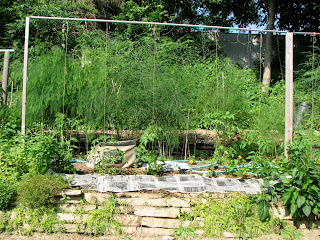I have long neglected the job of pruning and tying up the indeterminate tomatoes. It is time to get down to business. They were some of the first plants to go into the garden and they really need some attention.
Tomatoes fall into two general categories: determinate and indeterminate.
Determinate tomatoes are a bush variety tomato. They usually grow to three or four feet tall and set their fruit all at once. Most paste and canning type tomatoes are determinate by design. Growers can expect most of the fruit to ripen at once, to be canned, frozen, or made into salsas, sauces, etc. They require some support to keep the fruit off the ground. I plant mine in the scrounged tomato cages that I keep in my garden year round. (Scrounger's Note: Many people toss their tomato cages at the end of the season rather than store them. Keep your eyes open for them for your own garden. Skip the storage issue and keep them in the garden throughout the winter.) Determinate tomatoes should not be pruned. Smaller varieties of determinate tomatoes grow well in containers and make nice patio plants. I picked up some hanging baskets and shepherd’s crooks at a garage sale earlier in hopes of hanging some smaller tomatoes around the patio for easy snacking.
Indeterminate tomatoes are a vine-type tomato that can grow to ten feet. These varieties produce fruit all season and require much more staking and pruning. Most heirloom varieties are of the indeterminate type. In my garden, these plants give us our slicers and small snacking tomatoes. I have several different varieties this year. Indeterminate tomatoes make nice vertical gardening specimens. Mine line the path through my middle vegetable bed and I often grow herbs or onions between the plants.
My neighbor introduced me to this method of staking my indeterminate tomatoes. They had been overwhelming my tomato cages. My husband sank two 1x1” eight foot stakes and connected the span with a ten foot length of light-weight electrical conduit. I plant my tomatoes under the top support and train them up twine that is tied to the base of the tomato plant and to the conduit. I pinch back suckers to encourage a strong, central vine and promote fruit production. Check out Mel Bartholomew's "Square Foot Gardening" for more tips on easy to build structures for vertically grown tomatoes. Square Foot Gardening: A New Way to Garden in Less Space with Less WorkIn training my plants this way, I can take advantage of limited soil space. Companions can be planted amongst the tomato “tree trunks” to further economize on space. Fruit grows more at eye level and is easy to spot and pick. My children and I love to walk down a path of tomatoes, picking and eating our way through the garden.
For more information about tomato staking and pruning, check out this website.

No comments:
Post a Comment